Intel's 925X & LGA-775: Are Prescott 3.6 and PCI Express Graphics any Faster?
by Anand Lal Shimpi on June 21, 2004 12:05 PM EST- Posted in
- CPUs
LGA-775: Do we really need it?
The hot topic at Computex this year was Intel's new 775-pin LGA socket. Motherboard and memory manufacturers alike were complaining left and right about reliability issues with Intel's new socket, and with the launch less than a month away, we were obviously concerned as well.
First, why even bother with a new socket/interface? The Pentium 4 was doing just fine on Socket-478, and now with LGA-775, we're able to get another 200MHz? Seems silly, no?
While it's true that LGA-775 isn't necessary today, there are a couple of factors that dictate its necessity for tomorrow. As we've talked about before, a CPU's package can actually be a limiting factor when it comes to core clock speed as well as FSB frequency. Think about it this way; today's Pentium 4s run at a 800MHz FSB, meaning that the interface between the CPU and the chipset has to be capable of handling 800MHz signaling across a wide 64-bit bus. When we talk about the interface between the CPU and the chipset, physically, what are we talking about? We are talking about the traces on the motherboard going from the chipset to the CPU socket, the CPU socket itself and the pins on the CPU. Improvements in the pin interface are necessary in order to allow for higher FSB CPUs. While today's 800MHz FSB isn't really pushing the limits, remember that Prescott's replacement will be paired up with a 1.2GHz FSB.
The LGA-775 interface also packs the pins closer together, allowing 775 pins to exist in about the same space that 478 pins did on the old package. More tightly packed pins mean that we're dealing with shorter routes from the CPU's core to the external interface itself, also a desirable trait.
With more pins, we also have the ability to deliver more power, more reliably than before - which will also come in handy as Prescott and its successor ramp up to 5GHz. Intel banked quite heavily on clock speed with their NetBurst architecture, and part of the commitment was a commitment to new packaging technologies.
The other change that LGA-775 makes, and clearly the most controversial one, was to move the pins off of the CPU itself and onto the motherboard - meaning that the CPU itself is mostly flat underneath. The capacitors on the bottom of the CPU keep it from becoming perfectly flat, but the lack of pins definitely make it a flatter chip.
With no pins on the CPU, the first thing that should pop into your head is - "woohoo, no bent pins on your CPU." Unfortunately, with the pins on the motherboard, now you can have bent pins on your motherboard - and with the LGA-755 interface, they are much easier to bend, and much more difficult to unbend.
The problem with the LGA-775 socket is that you can't see the pins in the socket very well when you've got the CPU suspended in air above it. You have to be very gentle and very precise when placing the CPU on top of the pins because if you drop it on the pins or if you are just one pin off, you risk bending a lot of pins.
Although we haven't tried it yet, Intel has told us that once you bend a number of the pins on the socket itself, in essence, it's pretty much impossible to unbend them. Remember that we're talking about 775 very fragile pins in that socket - and we thought Socket-478 was bad.
There was another significant change in the socket structure with LGA-775: the locking lever. It used to be that the heatsink, not the socket's lever, was what provided the majority of force on the CPU itself to ensure secure installation in the socket (to prevent against package pullout and to guard against shearing the mechanical attach between socket and motherboard as well as the chipset and motherboard). Unfortunately, that meant that the heatsink had to supply upwards of 40 lbs of force to the CPU, which caused a lot of issues, the biggest of which was bending motherboards.
While Intel insists that the amount of bending caused by their heatsinks on Socket-478 motherboards was within tolerances, the fact of the matter is that with enough heatsink installations and removals, you could do some serious trace damage to your motherboard, thanks to the bending of the board.
With LGA-775, Intel has addressed the pressure problem and now it's the socket lever and not the heatsink that supplies the ~40 lbs of force to not only secure the chip but also make adequate contact between the CPU and the pins. The heatsink now has to provide much less force and thus, doesn't bend the motherboard as much.

The old heatsink used to bend the motherboard quite a bit...
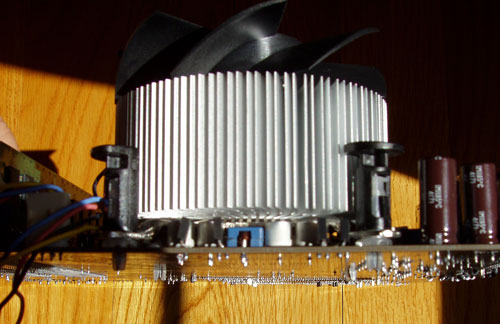
...but the new heatsink doesn't do so, not as much at least.
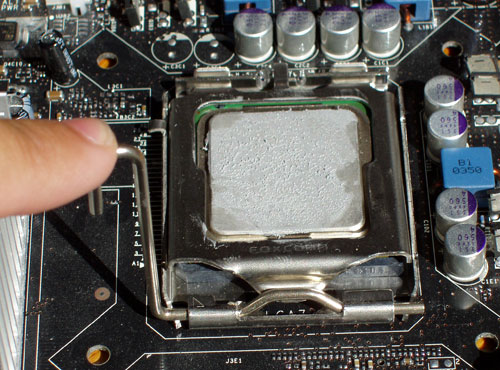
The socket's lever requires more force to engage, but it also puts much more force on the CPU than in the old socket.
Intel's new heatsink is actually a huge improvement over their old ones, thanks to the removal of heavy-duty downforce as one of its job requirements.
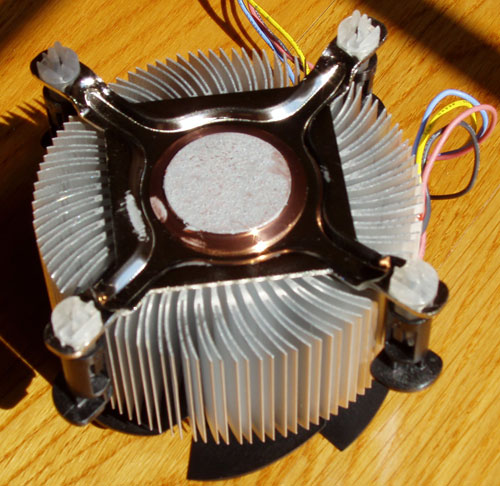
The four pegs of the heatsink basically plug into the holes in the motherboard, and you twist the tops of the pegs to have it locked. You have to make certain to twist the pegs securely; otherwise, the heatsink has a tendency to pop off. Luckily, Intel's thermal throttling prevents any serious damage from occurring as a result.
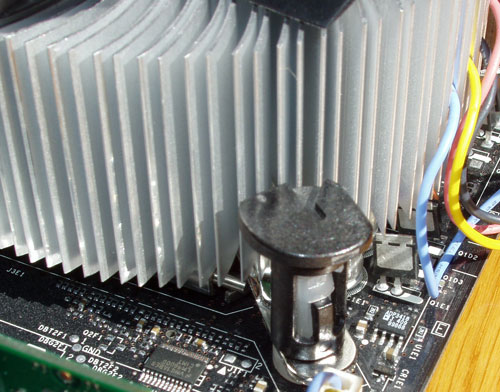
The bottom line is that a new CPU socket was necessary to continue with Intel's future CPU plans, but the fragility of LGA-775 definitely shows that Intel didn't take enthusiast users into consideration. Intel has neglected the enthusiast community in the past, and although we do make up a very small portion of the overall computing community, it's still an important group on which to focus. If you buy an LGA-775 board, just be very careful. We haven't had any problems yet, but we've been extremely careful with our installations.
It looks like LGA-775 will take us to the end of the Pentium 4 line, although we would have liked a more user-friendly socket to keep us company over the next couple of years.


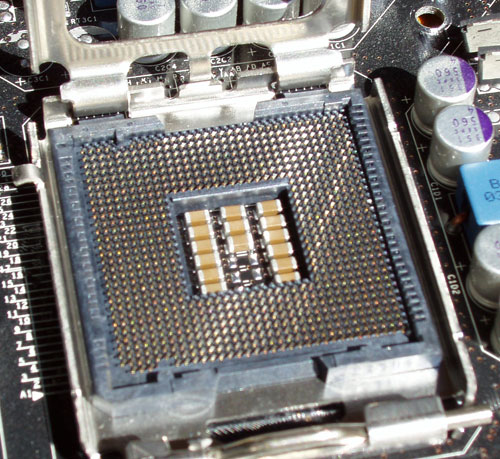
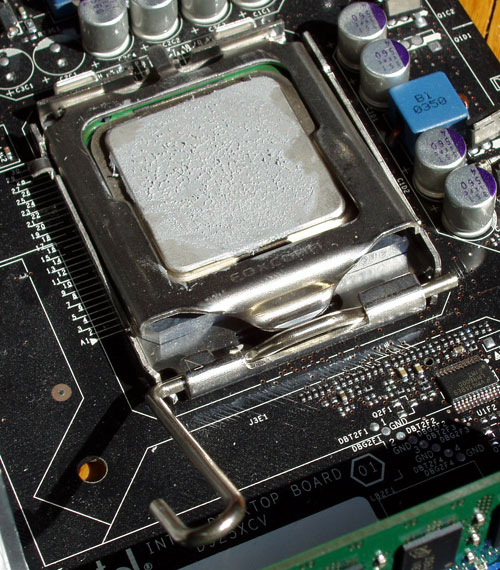
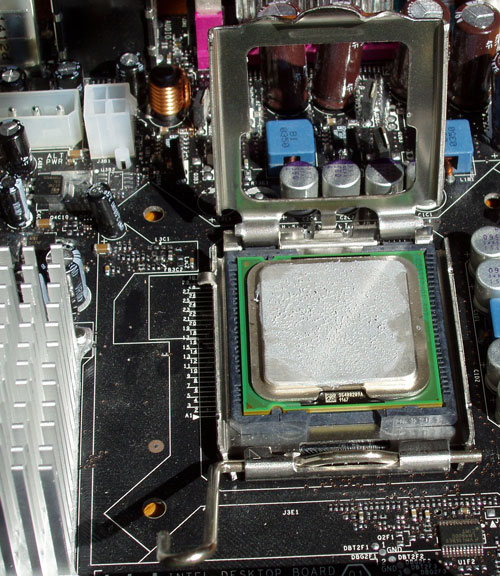








39 Comments
View All Comments
Phiro - Monday, June 21, 2004 - link
Great article, good pics on the new socket.I'm glad to see PCI-E performance is within a % or two of AGP-8X, and that Nvidia & ATI are neck and neck, no big hit on either one.
I think it was clear to anyone who has been following the move to PCI-E that the onus wasn't on a performance increase on a single card - the move to PCI-E is an engineering one, not a siloed performance gain. The idea is we have a much more robust bus, we can have many cards with tons of bandwidth instead of one, and we add alot of versatility.
It's like the move from VLB to PCI - anyone remember that? PCI was a good, good standard. While graphics cards didn't make a huge jump in performance, you finally got away from those damn ISA slots.
Anyhow. I think PCI-E is a good standard, and I'm going to have it in my next system.
RyanVM - Monday, June 21, 2004 - link
Why weren't there more comparisons between equal processors on the different platforms, such as LGA775 P4E vs. S478 P4E (2.8, 3.2, etc)? It seems to me that those would better isolate the chipset.ZobarStyl - Monday, June 21, 2004 - link
I don't think AMD solutions with PCI-E will be any faster...the reason that the benches using the new chipset with DDRII were considered even ground is that the companion article on the new Intel chipsets showed there is at this point no difference between the two setups in terms of performance, only in price. This generation of PCI-E solutions based on AGP designed chips (from both camps) wasn't really built with PCI-E bandwidth in mind, so the gains on any system are likely neglible. Once chips (and games too, I would assume) can be built with the bandwidth of PCI-E in mind perhaps we will see a gain, right now let rich kids upgrade while you sit back on a much cheaper AGP solution that gives the same perf. =)CU - Monday, June 21, 2004 - link
I think ATI said they were buffers and not a bridge. I could be wrong though.elephantman - Monday, June 21, 2004 - link
I'd have to agree with justly on that last oneAlso..I believe nvidia had posted an xray of ati's pcie core which showed a bridge solution and not a fully native pcie solution as stated...maybe we'll get a response from ati on this soon
justly - Monday, June 21, 2004 - link
This quote from page two is pure rubbish."It used to be that the heatsink, not the socket's lever, was what provided the majority of force on the CPU itself to ensure proper contact with the socket."
The force exerted on the CPU by the heatsink is used to maximize heat transfer. If the heatsink force was to provide "contact with the socket" then there would be no need for a lever (at least on a ZIF socket). This would also mean that no one should worry that a CPU could burn up without a heatsink, as it would not have "contact with the socket" without the force of the heatsink pushing down on it.
mkruer - Monday, June 21, 2004 - link
To be fair I would use the P4E for rendering IF it wasn’t a power hog. But since I doen render anything movies, I guess not.mkruer - Monday, June 21, 2004 - link
Hum interesting PCI Express offers virtually no gain because of DDR-2 latencies? I wonder how much better PCI Express would be on an AMD 64 with DDR-1? You don’t have the DDR-2 latencies issues, plus because of HT, that’s Hyper Transport for you Intel people out there, I wonder if in the long run the AMD systems will perform better for the graphics card on average then any Intel chipset. Anyway this confirms my suspicion, “never buy any first generation product form either company” and in Intel’s case this time you might want to wait for the Merom, Conroe and Tukwila, chips because I think everyone should stick a fork in the P4 it’s done! (pun intended)phobs - Monday, June 21, 2004 - link
Interesting read,Bit of a error on page 22, you say "concluding our AGP vs. PCI Express performance investigation." and then go on to have 2 more pages of benchmarks...